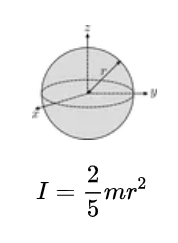 Home
Home
 Back
Back

Definition: This calculator computes the moment of inertia (\( I \)) of a rotating object about a specified axis, based on its shape, mass, dimensions, and axis of rotation.
Purpose: It is used in physics and engineering to analyze rotational motion, helping to understand how mass distribution affects an object's resistance to angular acceleration.
The calculator uses the following formulas for different shapes:
Ball (Solid): \[ I = \frac{2}{5} m r^2 \quad (\text{axis through center}) \] Circular Hoop (Thin): \[ I_z = m r^2 \quad (\text{axis parallel to z}) \] \[ I_x = I_y = \frac{1}{2} m r^2 \quad (\text{axis parallel to x or y}) \] Cuboid (Solid): \[ I_l = \frac{1}{12} m (w^2 + h^2) \quad (\text{axis parallel to length } l) \] \[ I_w = \frac{1}{12} m (l^2 + h^2) \quad (\text{axis parallel to width } w) \] \[ I_h = \frac{1}{12} m (l^2 + w^2) \quad (\text{axis parallel to height } h) \] \[ I_d = \frac{1}{6} m \frac{w^2 h^2 + l^2 h^2 + l^2 w^2}{l^2 + w^2 + h^2} \quad (\text{axis along longest diagonal } d) \] Cylinder (Solid): \[ I_z = \frac{1}{2} m r^2 \quad (\text{axis parallel to z}) \] \[ I_x = I_y = \frac{1}{12} m (3 r^2 + h^2) \quad (\text{axis parallel to x or y}) \] Cylindrical Tube: \[ I_z = \frac{1}{2} m (r_2^2 + r_1^2) \quad (\text{axis parallel to z}) \] \[ I_x = I_y = \frac{1}{12} m (3 (r_2^2 + r_1^2) + h^2) \quad (\text{axis parallel to x or y}) \] Where:
Unit Conversions:
Steps:
Calculating the moment of inertia is crucial for:
Examples:
Q: What is moment of inertia?
A: Moment of inertia, also known as mass moment of inertia, is a physical property of a rotating object that quantifies its resistance to angular acceleration, depending on the distribution of its mass relative to the axis of rotation.
Q: Why does the moment of inertia depend on the axis?
A: The moment of inertia depends on how the mass is distributed relative to the axis of rotation. Mass farther from the axis contributes more to the moment of inertia, increasing resistance to rotation.
Q: What is the significance of the moment of inertia in real life?
A: It is essential in designing rotating systems (e.g., engines, wheels) and understanding rotational motion in sports, machinery, and celestial mechanics.